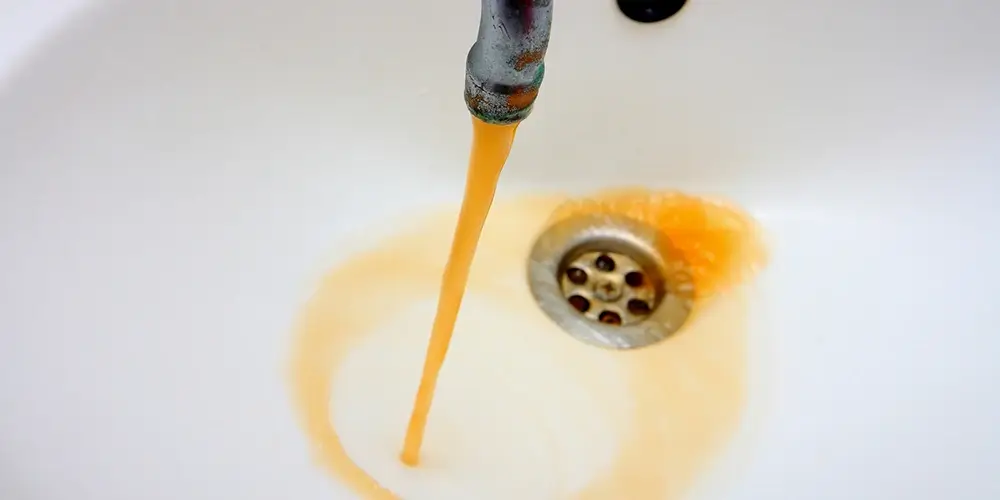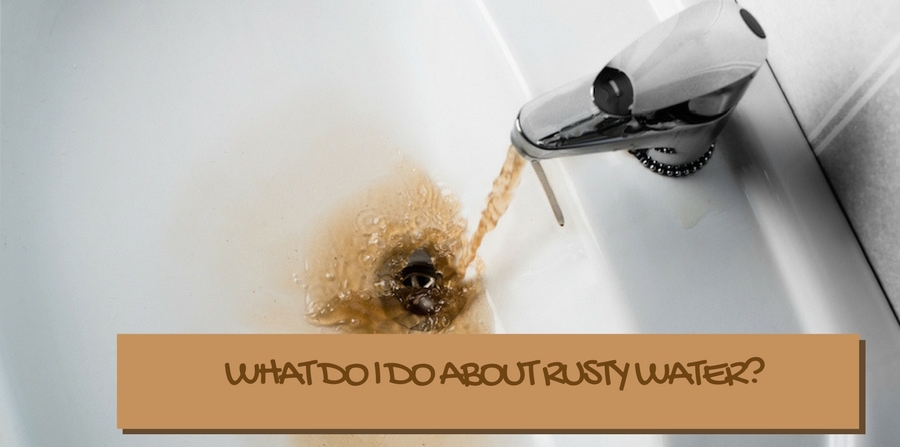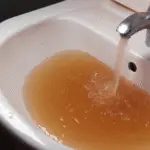Imagine coming home after a long day, ready to quench your thirst, but as you turn the tap, you’re greeted with rusty water. It’s unsettling, right?
You might wonder why this is happening and what it means for your health and home. Rusty tap water isn’t just a minor inconvenience; it’s a signal that something’s amiss. Could it be your pipes, or is there a bigger issue at play?
Understanding why your tap water is rusty is essential for maintaining a safe and healthy environment for you and your loved ones. We’ll unravel the mysteries behind the discoloration, offering you insights and solutions that will put your mind at ease and ensure your water runs clear again. Are you ready to discover the truth behind your rusty tap water? Let’s dive in.

Credit: orangecoastplumbing.net
Common Causes Of Rusty Tap Water
Rusty tap water can be a startling discovery. Understanding the causes can help address the issue effectively. Several factors contribute to this problem. Identifying these factors is the first step towards clear water.
Old Plumbing Systems
Many homes have old plumbing systems. These systems often have metal pipes. Over time, these pipes corrode. Corrosion leads to rust formation. Rust then mixes with tap water. Resulting in the reddish hue observed.
Pipe Sediment Buildup
Sediment can build up in pipes. This sediment contains rust particles. These particles mix with water. Especially after disturbances in water flow. Such disturbances can include construction or repairs. Rusty water often follows.
Breaks in water mains are a common cause. They disrupt the water supply. During repairs, rust can enter the system. This affects the water quality. Tap water can turn rusty temporarily.
High Iron Content In Water
Some areas have water with high iron content. Iron naturally causes discoloration. It interacts with oxygen, forming rust. This rust then dissolves in tap water. Giving it a rusty appearance.
Flushing Of Fire Hydrants
Fire hydrant flushing is essential for maintenance. It clears out sediment from pipes. However, this process can stir up rust. The rust then enters the water supply. Resulting in rusty tap water.

Credit: mikediamondservices.com
Aging Pipes And Infrastructure
Have you ever turned on your tap, only to find rusty water streaming out? This unsettling experience might be linked to aging pipes and infrastructure in your area. As pipes age, they can corrode and deteriorate, affecting the quality of water that flows through them. Understanding these underlying issues can help you address the problem effectively and ensure your water is safe to use.
Corroded Iron Pipes
Iron pipes, once a staple in plumbing, are notorious for corrosion over time. When iron reacts with water and oxygen, it forms rust. This rust can flake off and mix with your tap water, giving it a brownish tint.
If you live in an older home, your plumbing might be primarily composed of iron pipes. This means you could be dealing with rust issues frequently. It’s not just about unsightly water; prolonged exposure to rust can damage appliances and fixtures.
Have you noticed stains in your sink or bathtub? These might be signs of corroded iron pipes affecting your water supply. Consider seeking professional advice to replace old pipes with more modern materials.
Galvanized Steel Deterioration
Galvanized steel pipes were a popular choice in mid-20th century construction. They are steel pipes coated with a layer of zinc to prevent rust. However, this protective layer wears off over time, leading to corrosion.
If you’ve got galvanized steel in your plumbing system, you might experience reduced water pressure. As these pipes corrode, mineral deposits build up, restricting water flow.
Does your water have a metallic taste or smell? That’s another indicator of galvanized steel deterioration. Replacing these pipes with copper or plastic alternatives can solve the problem and improve your water quality.
Addressing aging infrastructure is crucial for maintaining clean and safe tap water. Are you ready to take action and ensure your water is free from rust? Understanding the condition of your pipes is the first step to a healthier home.
Water Main Breaks
Rusty tap water often signals a water main break. This disruption stirs up sediment in pipes. Resulting in discolored water flowing into homes.
Water main breaks can be a major nuisance, especially when they affect the quality of your tap water. Picture this: you turn on your faucet to fill a glass, only to be met with rusty, discolored water. It’s not just unappealing; it can make you question the safety of what’s coming out of your tap. Water main breaks often cause this issue, as they disrupt the normal flow of water, stirring up sediment and rust in the pipes. This can lead to a temporary, but noticeable, change in your water’s appearance and quality.Effects On Water Clarity
After a water main break, you might notice a change in water clarity. Sediments and rust, which usually settle at the bottom of pipes, get disturbed. This results in brown or yellow water flowing through your taps. It’s more than just an aesthetic issue; it can also affect your appliances. Dishwashers and washing machines can leave your dishes and clothes looking less than fresh. Have you ever experienced washing a load of white laundry only to have it come out stained? Rusty water can do that. It’s a clear sign that sediment has infiltrated your water supply. You might want to think twice before using your tap water during these times.Potential Health Risks
While rusty water might look unappetizing, it’s typically not harmful for short-term consumption. But long-term exposure can pose potential health risks. Iron and other metals in rust can be problematic for those with iron overload disorders. If you’re pregnant or have certain medical conditions, it’s best to err on the side of caution. Have you considered how these contaminants might affect your family’s health? Installing a good water filter can be a practical solution. It helps ensure that even if a water main break occurs, your water remains safe to drink. Testing your water regularly can also provide peace of mind. When was the last time you checked your water filter? Keeping it updated can be an essential step in maintaining water quality. Be proactive in ensuring your household’s safety and comfort.High Iron Content In Water Supply
High iron content in water can lead to rusty tap water. This issue often stems from natural sources or water supply systems. Understanding the root causes can help in addressing the problem effectively.
Natural Sources Of Iron
Iron is a common element in the Earth’s crust. It often finds its way into water supplies through soil and rocks. Rainwater can dissolve iron from these natural sources. This iron-rich water then enters rivers, lakes, and underground aquifers. As a result, your tap water may contain high levels of iron.
Impact On Water Quality
High iron content affects water quality. It changes the color and taste of your water. Rusty water can stain clothes and fixtures. It may also clog pipes and appliances. Though not harmful to health, it can be an inconvenience. Addressing high iron levels can improve your water’s appearance and usability.
Seasonal Changes And Weather Conditions
Seasonal changes and weather conditions can significantly influence the quality of your tap water. You might notice a rusty tint during certain times of the year. This is often linked to natural events that affect water supply systems.
Impact Of Heavy Rainfall
Heavy rainfall can cause sediments in water systems to become unsettled. This can result in rusty water flowing from your tap. If you’ve ever noticed cloudier water after a storm, this could be the culprit.
Water treatment plants usually handle these changes, but sometimes the volume of rainwater overwhelms the system. During these times, you might see more discoloration. Have you ever thought about how a simple rain shower could affect your daily routine in such an unexpected way?
Temperature Fluctuations
Changes in temperature can also impact your tap water’s clarity. When temperatures shift dramatically, it can affect the pipes and infrastructure. This often leads to rust particles becoming dislodged.
Think about the transition from winter to spring. Pipes expand and contract with temperature changes, which might disturb the mineral deposits inside. This isn’t something water treatment plants can always predict or control.
Have you noticed rusty water during certain seasons at your home? Understanding these patterns can help you anticipate and address the issue. It’s a small step towards ensuring cleaner water for you and your family.
Municipal Water System Maintenance
Experiencing rusty tap water? This often occurs due to aging pipes or maintenance activities. Iron particles may enter your water, causing discoloration. Regular municipal maintenance can help address this issue, ensuring cleaner and safer water for your home.
Maintaining a municipal water system is no small task. It involves various processes to ensure clean and safe drinking water for you and your community. However, sometimes these maintenance activities can cause temporary issues, such as rusty tap water. Understanding why this happens might just ease your concerns the next time you notice a change in your tap water.Hydrant Flushing Processes
Hydrant flushing is a routine procedure that can temporarily affect water color. During this process, water is forced through pipes at high speed to clean out any sediment buildup. This can stir up rust and minerals, leading to discolored water. Have you ever noticed your water turning brown after hydrant flushing in your area? It’s a common occurrence. The good news is, this discoloration is usually harmless and should clear up after a few hours. If you experience this, try running your cold water tap for a few minutes. This can help flush out the rusty water from your system more quickly.Water Treatment Adjustments
Occasionally, adjustments in water treatment can also lead to rusty tap water. When changes are made to the chemical balance or filtration methods, it can unsettle sediments and minerals. This might result in a temporary change in water clarity or color. Imagine waking up to find your morning coffee tasting a bit off due to water changes. It’s frustrating, but these adjustments are crucial for maintaining overall water quality. To minimize impact, check with your local water provider for updates on maintenance schedules. Being informed can help you prepare and manage any temporary water issues. Have you ever wondered how often these maintenance activities occur? Understanding this can give you insight into the efforts made to ensure your water remains safe and clean. Your awareness can also help you handle minor inconveniences with greater patience and understanding.Identifying The Source Of Rusty Water
Rusty tap water can be a common issue in homes. It can be unsettling to find reddish-brown water flowing from your faucet. Understanding the source of this problem is essential. Knowing where it originates can help you fix it effectively. Two main areas to investigate are your home plumbing and local water supply.
Home Plumbing Inspection
Start by inspecting your home plumbing system. Old pipes can corrode over time. This corrosion often causes rust to enter your water. Look for signs of rust on visible pipes. Pay attention to any leaks or damp areas. These may indicate pipe damage. You might also notice rust in your water heater. It can also contribute to rusty water. Regular maintenance can prevent these issues. If unsure, consult a professional plumber.
Consulting With Water Authorities
Sometimes, rusty water isn’t a home issue. It might be due to the local water supply. Contact your local water authorities to inquire. They can provide information about water quality. Ask if there are any ongoing issues or repairs. These can affect water clarity. Water mains may also be the culprit. They can sometimes rust and contaminate your water. Authorities might already have plans to fix the problem.

Credit: mytapscore.com
Solutions And Preventive Measures
Rusty tap water can be quite alarming. It often signals underlying issues with your plumbing or water supply. Addressing these problems is essential for maintaining clean, safe drinking water. Understanding effective solutions and preventive measures can help ensure your water remains pristine.
Replacing Old Pipes
Old pipes can deteriorate over time. Rust and corrosion may develop. This leads to rusty water flowing from your taps. Replacing these pipes is a significant step in resolving the issue. Choose pipes made from corrosion-resistant materials. Copper or plastic are excellent options. They prevent rust buildup and maintain water quality. Hiring a professional plumber ensures proper installation. This minimizes future plumbing issues.
Installing Water Filtration Systems
Water filtration systems offer an effective solution. They remove impurities, including rust, from tap water. Several types are available. Carbon filters are commonly used. They capture rust particles and other contaminants. Reverse osmosis systems provide thorough filtration. They remove most impurities from water. Install a system suitable for your household needs. Regular maintenance is crucial. Clean or replace filters as needed. This ensures optimal performance and clean water.
Frequently Asked Questions
Why Does Tap Water Turn Rusty?
Rusty water often comes from corroded pipes. Iron particles mix with water, causing discoloration.
Is Rusty Water Safe To Drink?
It’s best to avoid drinking rusty water. It may contain harmful substances. Boiling doesn’t remove rust.
How Can I Fix Rusty Tap Water?
Check pipes for corrosion. Call a plumber for inspection. Use water filters to remove particles.
What Are The Health Risks Of Rusty Water?
Rusty water can lead to stomach upset. Long-term exposure may cause health issues. Avoid ingestion.
Can Rusty Water Affect Appliances?
Yes, rusty water can damage appliances. It may clog filters and affect efficiency. Regular maintenance helps.
Conclusion
Rusty tap water signals issues needing attention. Corroded pipes or mineral deposits could be the cause. Check plumbing for rust or damage. Clean pipes regularly to prevent corrosion. Use water filters for safer drinking. Maintain your plumbing system to ensure clean water.
Consult a professional plumber for persistent problems. Don’t ignore rusty water signs. Protect your health and plumbing. Stay informed about water quality in your area. Regular inspections help avoid surprises. Drink with confidence from your tap. Prioritize clean water for your home and family.




